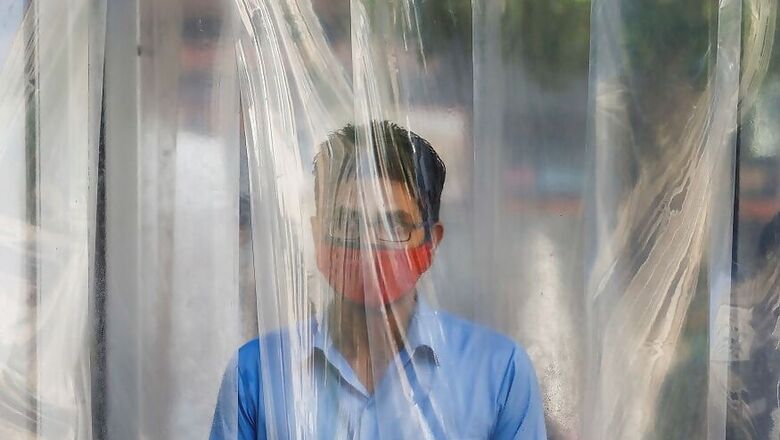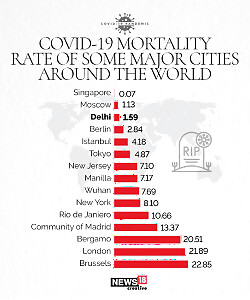Delhi's Covid-19 Mortality Rate Among Lowest in The World amid Allegations of Under-reporting Deaths

views
Delhi has reported 11,659 coronavirus cases – the second-highest in the country so far – after Mumbai. It also recorded its highest surge with 571 new cases on May 21. It has reported more than 500 cases each in the last three days (500 on May 19 and 534 on May 20).
Delhi was unlucky with its initial rise in cases, linked to two major events – the inflow of passengers from other countries in February-March and the Nizamuddin Markaz event accounting for at least 1,080 cases.
Despite a high number of cases, what is startling is the corresponding number of deaths. Delhi has reported just 194 fatalities so far and has one of the lowest mortality rates not only among major cities in India but in the world. Even with the 500-plus surge in the last three days, the number of corresponding deaths – six, 10 and 18 – has been incredibly low.
This is remarkable keeping in mind that both the central and Delhi governments have considerably eased norms in the national capital post lockdown 3.0.
Mortality Rate Delhi vs Indian cities

As per data updated till May 20, Delhi is second only to Chennai in mortality rate among major cities in India. But the national capital is three-and-a-half times the size and double the population of Chennai and so its efforts in controlling the number of deaths stands out.
Delhi’s mortality rate of just 1.59 is also among the lowest when compared with some of the major cities around the world. Just for perspective, it is 14 times lower than Brussels, 13 times than London, 12 times Bergamo, and 10 times Rio de Janiero. It is even better than Berlin, which was hailed as a model for containment of Covid-19 deaths.
Mortality Rate – major cities of the world

Along with the low mortality rate, Delhi also has a very low death rate (DR) per 1 lakh people. Its DR of 0.88 is better than Kolkata (1.13), Mumbai (3.92), Ahmedabad (7.38) and Pune (3.09) among others. Of course, it can be argued that Delhi’s large population gives it a lower DR. But DR is also a function of the number of deaths, so it is to Delhi’s credit that in spite of the large population it has managed to control the number of the deceased (unlike Mumbai).
At least 5,192 people have recovered in Delhi, which implies that its recovery rate (RR) of 47% is among the highest in comparison to other major cities in India. Just for perspective, Mumbai has an RR of 19.1%, Ahmedabad (33.8%), Chennai (25%) and Kolkata (36.6%). Compared to major states, Maharashtra has an RR of 26%, Tamil Nadu (45%), Gujarat (42%), Uttar Pradesh (59%), West Bengal (37%), Karnataka (38%) and Andhra Pradesh (63%).
“If the recovery rate is high and death rate low, the disease will not be as scary. Delhi’s recovery rate is high. People are contracting the disease but are also recovering,” said Delhi Chief Minister Arvind Kejriwal recently.
Delhi had also conduced 1,50,282 Covid-19 tests by May 20, which meant it was conducting 7,585 tests per million people – among the highest in India (compared to other states). Coupled with this is its tests/death ratio of 854 – higher than the national average of 762.
How has the administration prevented loss of lives despite surge in cases?
Sources in the Delhi government give credit to the healthcare system and its preparedness in treating the patients. Kejriwal said Delhi had boosted the medical facilities to accommodate the rush of patients by adding more beds and ventilators and making sure there were enough PPE kits for the staff. Eight private and six government hospitals are designated to treat Covid-19 patients in Delhi.
“Our focus is on bringing down the death rate. If you look at the figures in Delhi, the rate is already low. There are close to 1,800 people admitted in hospitals and of those only about 150 are in a serious condition. I am personally tracking the progress of each,” Kejriwal said on May 19.
However, recent reports have claimed the Delhi administration is under-reporting the number of coronavirus deaths. There is a mis-match between the number of deaths reported and the cumulative numbers from the hospitals – this was first highlighted in a news report on May 8 in The National Herald – a paper with political affiliations to the Congress party. Delhi Health Minister Satyender Jain said the discrepancy was there as many hospitals fail to send summaries when they report deaths.
The Delhi government had clarified on May 15 that it reports the number of deaths where the primary cause of the death is coronavirus. The deaths are audited by a three-member committee formed by the government.
There also seems to be a brewing confrontation between the BJP-ruled Municipal Corporations and the Delhi government over the number of Covid-19 deaths. The North and South Delhi Municipal Corporations claimed to have recorded 426 Covid-19 cremations at six designated burial grounds till May 16.
The Delhi government, while acknowledging the reports from both corporations, added that neither had submitted supporting documents and reports for the bodies they claimed had tested positive.
“The health bulletin reports death as declared by the Death Audit Committee. In the report submitted by the MCDs, a significant number of cases did not have the necessary documents. After studying all the reports, the number declared by the Death Audit Committee was found to be accurate,” said a government spokesperson.
The Kejriwal government on Sunday also issued an order stating there was no need to test dead bodies for Covid-19 – some other states are also following this procedure, which is against the guidelines of the ICMR and WHO. While experts are divided on testing dead bodies for Covid-19, they insist classification of death is important.
In the days to come, the controversy over Covid-19 deaths in Delhi will become clearer but it would be appropriate until then to take the official count as the actual count of Covid-19 deaths in the capital.
And if that holds, credit should be given where it is due.




















Comments
0 comment